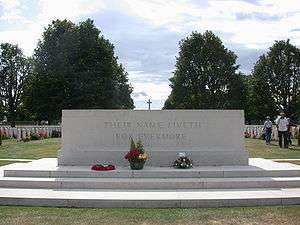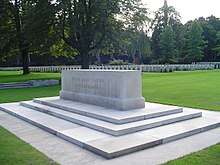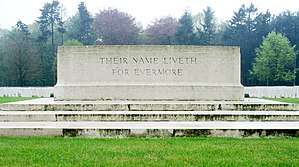Stone of Remembrance
The Stone of Remembrance was designed by the British architect Sir Edwin Lutyens for the Imperial War Graves Commission (IWGC).[lower-alpha 1] It was designed to commemorate the dead of World War I, to be used in IWGC war cemeteries containing 1000 or more graves, or at memorial sites commemorating more than 1000 war dead. Hundreds were erected following World War I, and it has since been used in cemeteries containing the Commonwealth dead of World War II as well. It is intended to commemorate those "of all faiths and none",[1] and has been described as one of Lutyens' "most important and powerful works",[2] with a "brooding, sentinel-like presence wherever used".[2]

Design
The initial thoughts for the design were sent by Lutyens in letters and memoranda in May and August 1917 to Fabian Ware, the founder and head of the Imperial War Graves Commission, before and after the period in which Lutyens and other architects visited the wartime cemeteries in France in July 1917 at the request of Ware, to give their initial thoughts on what should be done to commemorate the dead:
On platforms made of not less than three steps... place one great stone of fine proportion 12 feet long and finely wrot – without undue ornament and tricky and elaborate carvings – and inscribe thereon one thought in clear letters so that all men for all times may read and know the reason why these stones are placed throughout France – facing the West and facing the men who lie looking ever eastward towards the enemy.
— Letter from Lutyens to Ware in May 1917, quoted from Lutyens and the Great War (2009)[3]
Part of the design is the three-stepped platform on which each stone rests. Architectural historian Gavin Stamp, in Silent Cities (1977), quotes further from Lutyen's 1917 correspondence with Ware, where Lutyens describes the proposed stone as:
...one great fair stone of fine proportions, twelve feet in length, lying raised upon three steps, of which the first and third shall be twice the width of the second.
— Memorandum from Lutyens to Ware in August 1917, quoted from Silent Cities (1977)[4]
In a later work in 2006, Stamp identifies a similarly abstract and geometrical concept that was part of Lutyens' creative process, citing a letter that Lutyens wrote to his wife while on the July 1917 visit to France, describing how a 'solid ball of bronze' could be used to make a permanent monument.[5]
By the time of Ware's 1937 report, published as The Immortal Heritage the same year, some 560 Stones of Remembrance had been erected for World War I cemeteries and memorials in France and Belgium alone.[5]
Symbolism


The Stone of Remembrance is one of the standard architectural features of Commonwealth War Graves Commission cemeteries and memorials, the other being the Cross of Sacrifice by Reginald Blomfield. In contrast, the design for the Stone deliberately avoided "shapes associated with particular religions".[1] The shape of the Stone has been compared both to that of a sarcophagus[6] and an altar,[lower-alpha 2] but was always intended to be abstract and appeal to all denominations.
There was, however, controversy over the symbolism, both during the design and approval process and subsequently. Lutyens and those supporting the concept of secular architecture and equality of remembrance (including Ware) had to contend with those (including other architects advising the Commission and Anglican bishops) who wanted the overt Christian symbolism of a cross, or who objected to the pagan overtones of the proposed Stone. Lutyens corresponded with a wide variety of people to gain support for his idea. Eventually (by January 1918), the decision to use both Cross and Stone was taken, and the two designs were adopted in different ways.[3] Blomfield's Cross was built in different sizes according to the size of the cemetery, with Lutyens' Stone staying the same size but not being used in the smaller cemeteries (of less than 1,000 burials) where it was thought it would overwhelm the setting.
Geometry
The geometry of the stone structure was "based on studies of the Parthenon".[1] According to the Australian Government Department of Veterans' Affairs each stone is 3.5 metres long and 1.5 metres high.[6][lower-alpha 3] It was designed using the principle of entasis.[2] This involved incorporating subtle curves into the design, so that the stone does not have straight sides, but has circular lines that if extended would form a sphere 1,801 feet and 8 inches (549.15 metres) in diameter.[5] The effect of the stone monument has been attributed to its geometry: "...its curious power and symbolic strength derive from its careful proportions and the application of a subtle entasis to all its surfaces."[4]
Inscription
The phrase inscribed on the stone, one of several suggested during the design phase, was proposed by the British author, poet and Nobel laureate Rudyard Kipling, whose only son had died in the war. Kipling's role was to advise the IWGC (now CWGC) on inscriptions and other literary matters, and the phrase used on the Stones of Remembrance is a quote from the Wisdom of Sirach.[3]
Gallery
 Bretteville-sur-Laize Cemetery
Bretteville-sur-Laize Cemetery_1.jpg) Thiepval Memorial
Thiepval Memorial Ortona Cemetery
Ortona Cemetery Berlin War Cemetery
Berlin War Cemetery Niederzwehren Cemetery
Niederzwehren Cemetery- Sai Wan Cemetery,
Hong Kong  Buttes New British Cemetery, Belgium
Buttes New British Cemetery, Belgium- Rookwood Garden of Remembrance
 Kemmel Chateau Military Cemetery
Kemmel Chateau Military Cemetery- Holten Canadian War Cemetery
Notes
- The Imperial War Graves Commission was renamed as the Commonwealth War Graves Commission in 1960.
- Those referring to the Stone as an altar included Lutyens himself, who was reported by Stamp (2006) to have written to the Archbishop of Canterbury in 1923 saying that he was pleased to see that a newspaper report had described a "Great War Stone" being "used as an Altar for the administration of Holy Communion". Lutyens also referred to his design as an altar in correspondence with Ware, as reported by Skelton and Gliddon (2009) from the CWGC archives of minutes from a meeting held in France in July 1917, where Lutyens proposed: '[a] monolithic Altar [...] which should appeal to every feeling and denomination'.
- Although as noted above, Lutyens himself specified that the length should be 12 feet (3.66 metres).
References
- Architecture, Commonwealth War Graves Commission, accessed 01/03/2010
- Remembering the Great War with Lutyens, Tim Skelton, British Archaeology, Issue 109, Nov / Dec 2009
- Lutyens and the Great War (2009; Tim Skelton and Gerald Gliddon), Chapter 3 "The War Stone"
- Silent Cities – An Exhibition of the Memorial and Cemetery Architecture of the Great War, Gavin Stamp, 1977, published by the RIBA
- The Memorial to the Missing of the Somme, Gavin Stamp, 2006
- Stone of Remembrance, Australian Government Department of Veterans' Affairs, accessed 01/03/2010.
External links
| Wikimedia Commons has media related to Stones of Remembrance. |
- The Secret of the Cenotaph, Andrew Crompton, AA Files 34, 1999, pages 64–67
- Lutyens and Le Corbusier: from heritage to history, Jane Ridley, 3 October 2001